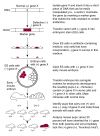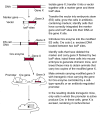New genetic technologies in alcohol research
- PMID: 15706740
- PMCID: PMC6827684
New genetic technologies in alcohol research
Abstract
Recently developed approaches to creating genetically engineered animals have expanded researchers' repertoire of methods to investigate the roles of individual genes in the development of certain behaviors and diseases, including alcoholism. For example, knockout mice, in which single mouse genes have been inactivated, have allowed scientists to assess the roles of those genes in mediating some of alcohol's effects. This approach has been further refined using conditional gene knockout technology, which allows the inactivation of a gene only in certain cells or during specific developmental periods. Alternatively, transgenic mice (i.e., mice that carry a foreign gene in addition to their own genes) have been created in which researchers can activate or inactivate the foreign gene at will. Although these genetic engineering technologies have not yet been used extensively in alcohol research, they offer great promise in analyzing the functions of genes that may be involved in determining alcohol's effects on the body and the development of alcoholism.
Figures




References
-
- Agah R, Frenkel PA, French BA, Michael LH, Overbeek PA, Schneider MD. Gene recombination in postmitotic cells: Targeted expression of Cre recombinase provokes cardiac-restricted, site-specific rearrangement in adult ventricular muscle in vivo. Journal of Clinical Investigation. 1997;100(1):169–179. - PMC - PubMed
-
- Capecchi MR. Targeted gene replacement. Scientific American. 1994 Mar;:34–41. - PubMed
-
- Crabbe JC, Phillips TJ, Feller DJ, Hen R, Wenger CD, Lessov CN, Schafer GL. Elevated alcohol consumption in null mutant mice lacking 5-HT1B serotonin receptors. Nature Genetics. 1996;14:98–101. - PubMed
-
- Fink DJ, Glorioso JC. Engineering herpes simplex virus vectors for gene transfer to neurons. Nature Medicine. 1997;3(3):357–359. - PubMed
-
- Galli-Taliadoros LA, Sedgwick JD, Wood SA, Körner H. Gene knock-out technology: A methodological overview for the interested novice. Journal of Immunological Methods. 1995;181(1):1–15. - PubMed
Publication types
MeSH terms
LinkOut - more resources
Full Text Sources
Medical
